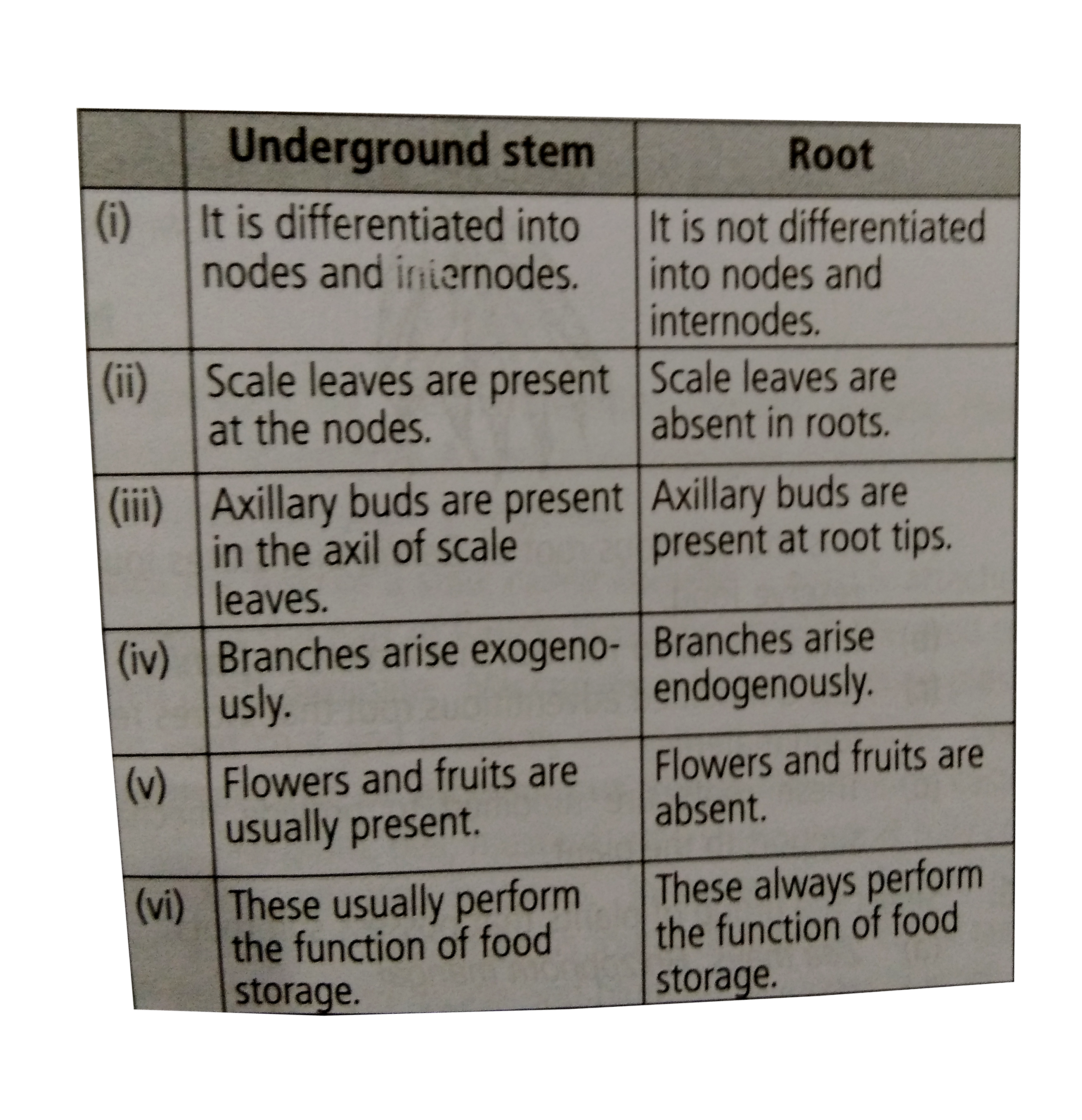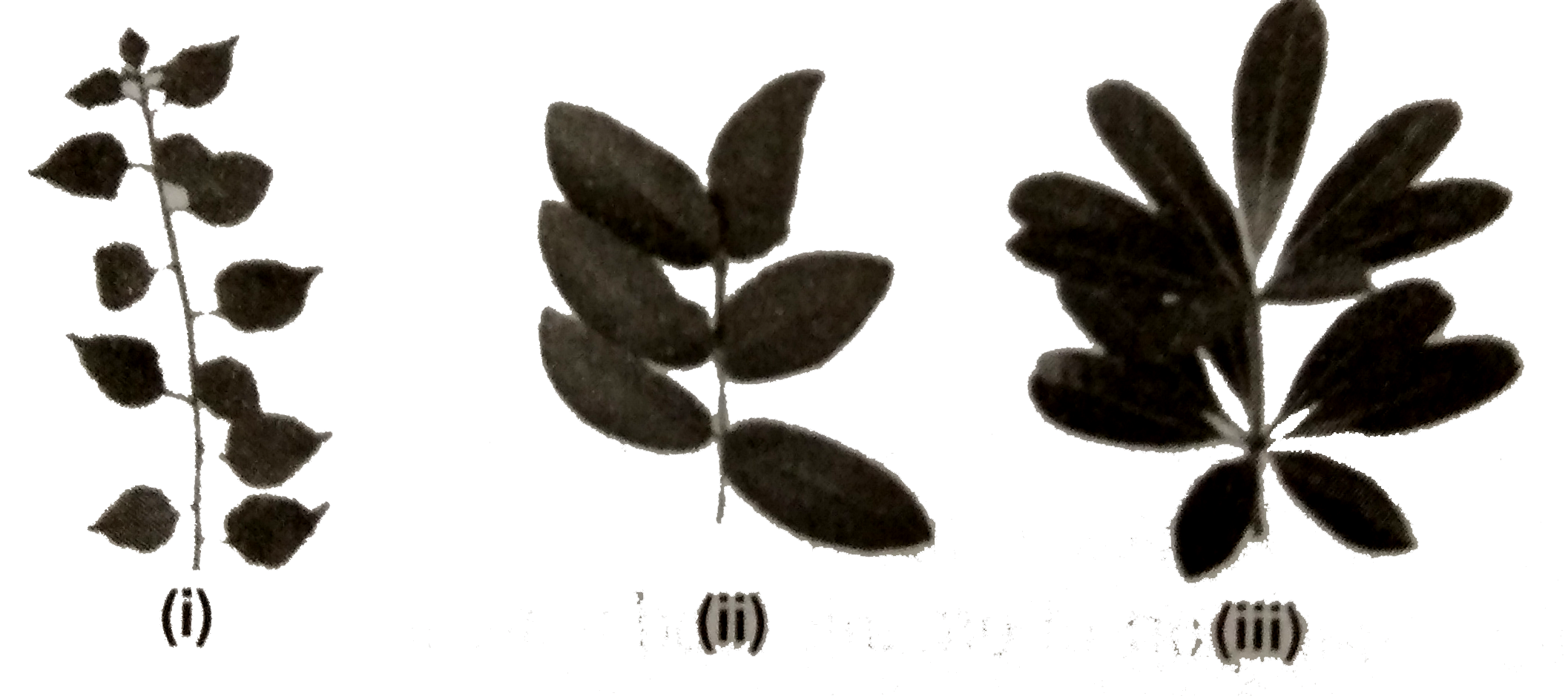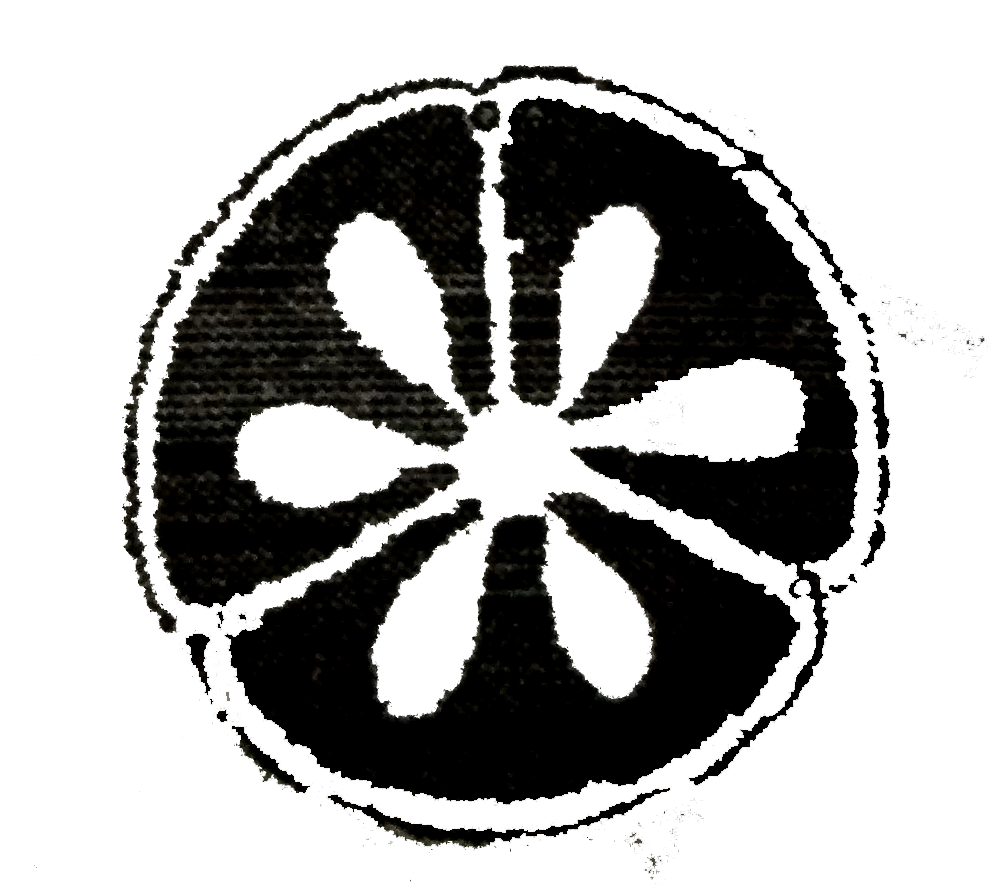Complete Solutions to Morphology Of Flowering Plants of chapter MORPHOLOGY OF FLOWERING PLANTS of Class 11 book with complete answers and questions
| Class 11 | BIOLOGY |
| Chapter | MORPHOLOGY OF FLOWERING PLANTS |
| NCERT FINGERTIPS | Morphology Of Flowering Plants |
| Number Of Questions | 100 |
| Academic Year | 2023-24 |
Refer to the given figure and select the incorrect statements regarding this.

View SolutionRead the given statements and select the correct option. Statement-1: Root cap protects the root meristem from the frition of the soil and its outer cells are continously replaced by newer ones.
Statemnent 2 : The effect of the coil-friction damages the outer cells of root cap which are peeled off and replaced by new cells produced by root meristem.
View SolutionWhich of the following statements is correct with respect to the given figure showing different zones of a typical root?

View SolutionEdible roots are found in
View SolutionIdentify the type of modified root and select the correct statements regarding it

View SolutionSelect the group of plants that posess stilt roots.
View SolutionSelect the mismatched pair
View SolutionWhich of the following plants bears moniliform roots ?
View SolutionMatch column I with column II and select the correct option from the given codes.
`{:("Column I",,"Column II"),("(Type of fleshy taproot)",,"(Example)"),("(A). Conical",,"(i) Brassica rapa"),("(B). Fusiform",,"(ii) Dauscus carota"),("(C). Napiform",,"(iii) Raphanus Sativus"),("(D). Tuberous ",, "(iv) Mirabilis jalapa"):}`
View SolutionSelect the incorrect statement out of the following.
View SolutionGiven are some difference between an underground stem and a root. Select the option that identifies the incorrect pair of differences.

View SolutionUnbranched, erect, cylindrical stouta axis with distinct nodes and internodes and with joined appearance is called as
View SolutionWhich of the following plants possesses culm
View SolutionMatch column I with column II and select the correct option from the given codes.
`{:("Column I",,"Column II"),("(A) Vegetative bonds",,"(i) buds develop in axils of leaves"),("(B) Floral buds",,"(ii) Buds produce leafy shoots"),("(C) Axillary buds",,"(iii) Reproductive buds that produce flowers"),("(D) Accessory buds",,"(iv) Additonal buds borne at leaf bases"):}`
View SolutionRead the given statements and select the correct ones.
(i) Root caps are present in prop roots.
(ii) Pneumatophores help to get oxygen for respiration.
(iii) Edible part of ginger is underground stem.
(iv) Hydrophytes usually possess a well developed root system.
View SolutionRead the following statements and select the correct option.
Statement -1 : the stem tubers are the swollen ends of spcialised underground stem branches, which help in vegetative propagation of the plant.
Statement-2 : Solanum tuberosum is an example of a stem tuber which stores inulin as the main reserve food material.
View SolutionWhich of the following is not an example of corm
View SolutionThe 'eyes' of the potato tuber represent
View SolutionIn Bougainvillea, weak stems rise up a support by clinging to it with the helo of curverd thorns, such plants are called as
View SolutionIn Opuntia, the function of photosynthesis is carried out by
View Solution_______are the green stems of limited growth which have taken over the function of photosynthesis from leaves.
View SolutionFollowing table summerises the comparisions between phylloclades and cladodes (cladophylls).


Pick up the wrong differences and select the correct option
View SolutionWith respect to the given figure, select the correct option

View SolutionMatch column I with column II and select the correct option from the given codes.
`{:("Column I",,"Column II"),("A. Thorns",,"(i) Vegetative propagation"),("B. Phylloclades",,"(ii) Defensive mechanism"),("C. Runners",,"(iii) Mechanical support"),("D. Haustoria",,"(v) Photosynthesis"):}`
View Solution_________are one internodes long runners, usually found in rosette plants at the ground/water level.
View SolutionSelect the mismatched pair out of the following
View SolutionIn some_______, the leaf base may became swollen and is called as ________.
View SolutionWhich of the following represents the functions of veins in the leaves ?
View SolutionReticulate venation is a characteristic of dicots. An exception to this generalisation is
View SolutionParallel venation is a characteristic of monocots. Which of the following is an exception to this generalisation ?
View SolutionWhich of the following kinds of venation is present in banana ?
View SolutionStudy the following flow chart and select the correct option for P, Q, R and S.

View SolutionA simple leaf can be differentiated from the pinnae of a compound leaf on the basis of presence or absence of
View SolutionFinely dissected leaf may be an adaptation of
View SolutionStudy the given figures and identify the kind of phyllotaxy

View SolutionIn spiral phyllotaxy, the number of leaves at each node is
View SolutionIn_________ phyllotaxy, a pair of leaves arise at each node and lie opposite to each other as in________plants
View SolutionIndetify the group of plants possessing leaf tendrils
View SolutionDifferent parts of a leaf are modified into tendrils which helps the plant in climbing up. Identify the type of tendril that is seen in Clematis
View SolutionLeaf tip tendrils are present in
View SolutionSpines present on the areoles of Opunita represent
View SolutionThe given figure represent the V.S. of bulbs of Allium cepa identify the different parts and select the correct options

View SolutionWhich of the following represents the edible swollen portion of Allium cepa ?
View SolutionWhich of the following plants parts in garlic and onion are edible ?
View SolutionWhich of the following is an incorrect pair ?
View SolutionParkinsonia is a good example of
View SolutionSelect the incorrect mathch with respect to the plant and the relavitve pants part modified for food stoarage.
View SolutionWhich plants part is modified into pitcher in pitcher plants ?
View SolutionA small rootless aquatic herb in which a portion of leaf foms a tiny sach or bladder which traps water insects is
View SolutionThe given figure shows some types fo inflorescences. Select the option that correctly identifies them.

View Solution_________inflorescence is a compact spike-like inflorescence with small unisexual flowers.
View SolutionIn `ul(" (i) ")` type of inflorescence, main axis terminates in a flower, hence is limited in growth and flowers are borne in `ul (" (ii)" )` Succession.
View SolutionIdentify the types of inflorescence shown in the figure and select the correct option for A and B .

View SolutionMatch column I with column II and select the correct option from the given codes.
`{:("Column I",,"Column II"),("A. Pedicel",,"(i) Reduced leaf"),("B. Peduncle",,"(ii) Stalk of the flower"),("C. Bract",,"(iii) Stalk of the leaf"),("D. Petiole",,"(iv) Inflorescences axis"):}`
View SolutionRefer to the given figures, showing relative position of different floral parts on the thalamus and select the correct option .

View SolutionIf the gynoecium is present in the topmost position of the thalamus, then the flower is referred to as
View SolutionRead the given statements
(i) Gynoecium occupies the highest position while the other floral parts are situated below it.
(ii) Overy is superior.
(iii) Examples are Brassica, Hibiscus, brinjal, etc.
Which condition of flowers is being described by the above the statements ?
View SolutionOvary is said to be half inferior in which of the following conditions ?
View SolutionIn __________flowers, margin of thalamus grows upward enclosing the overy completely and getting fused with it.
View SolutionBased on the position of floral parts on thalamus, the flowers, are described as hypogynous, perigynous and epigynous. Which of the following floral forms (A-D) represents the flowers of Rosa and Prunus respectively ?

View SolutionIndetify the different types of astivation (A,B ,C and D) and select the correct option.

View SolutionIn________aestivation, sepals or petals in a whorl just touch one another at the margins, without overlaping, as is found in_____
View SolutionThe given figure represents vexillary aestivation. Select the suitable labels for P,Q and R

View SolutionSelect the correct option for A,B and C in the given diagram of papilionaceous corolla.

View SolutionFind out the incorrect match
View SolutionSelect the incorrect pair out of the following
View SolutionSyngernesious condition of stamens is found in family
View SolutionMonothecous condtion of stamens, i.e,. Presence of a signle anther lobe is characterstic of family
View SolutionIndentify the different types of placentation shown in figure and select the correct option .

View SolutionIn_________placentation, a monocarpellary overy bears a sigle longitudinal ovule along the junction of two fused margins.
View SolutionWhich kind of placentation is represented by the given figure ?

View SolutionWhich of the following figures represents a typical placentation as seen in Hibiscus rosa sinensis (China rose)?
View SolutionOvery is one-chambered but it becomes two-chambered due to the formation of false septum in
View SolutionMatch column I with column II and select the correct option from given codes.
`{:("Column I" ,,"Column II"),("A. Marginal",,"(i) Sunflower, marigold"),("B. parietal",,"(ii) Pea"),("C Axile",,"(iii) Mustard,Argemone"),("D. Free central",,"(iv) Hibiscus,Argemone"),("E. Basal",,"(v) Dianthus, Primorse"):}`
View SolutionGiven figure represents a drupe of mango. Select the option that correctly identifies A, B, C and D

View SolutionMaize grain is a fruit known as
View SolutionEdible part of apple and pear is
View Solution
Select the incorrect the statements the given figure .
View Solution
Identify the given types of fruit select the correct option.
View SolutionSelect the mismatched pair out of the following
View SolutionX is scar on the seed coat through which the following seeds were attached to the fruit, above the X is a small pore called Y.
Identify X and Y and select the correct option .
View SolutionRefer to the given figures showing structure of dicotyledonous seed and select the option that correctly identifies any of the labelled parts

View SolutionEndospermic seeds are found in
View SolutionIn albuminous seeds, food is stored in ______and in exalbuminous seeds, food is stored in_______.
View SolutionCereals, castor and coconut possess _________seeds.
View SolutionMonocotylendonous seeds possess a single cotyledon which is represented by
View SolutionCoeorhiza and coleoptile are the protective sheaths coverging_______and__________respectively.
View SolutionGiven figure represents longitudinal section of a monocotyledonous embryo.
Identify the parts labelled as A,B, C and D from the list (i-vii) and select the correct option

(i) Scutellum
(ii) Coleoptile
(iii) Shoot apex
(iv) Epiblast
(v) Radicle
(vi) Root Cap
(vii) Coleorhiza
View SolutionWhich floral conditions are represented by the symbols `o+` and % respectively ?
View SolutionWhich of the following symbols denotes presence of tepals and epitepalous stemens in a flower ?
View SolutionMarginal placentation is generally found in family
View SolutionIdentify the correct feature of the family to which given floral formula belongs.

View SolutionAdd the missing floral organs in the given floral formula of Family Fabaceae.

View SolutionWhich floral family has (9)+1 arragements of enters in the androecium ?
View SolutionMatch column I with column II and select the correct option from the given codes
`{:("Column I",,"Column II"),("(Members of Fabaceae)",,"(Economic importance)"),("A. Gram, sem, moong, soybean",,"(i) Timber"),("B. Soybean , groundnut",, "(ii) Medicine"),("C. Indigofera",,"(iii) Fodder"),("D. Sunhemp",, "(iv) Fiberes"),("E. Sesbania, Triforlium",,"(v) Dye"),("F. GDalbergia sissoo",,"(vi) Edible oil"),("G. Glycyrrhiza glabra ",,"(vii) Pulses"):}`
View SolutionA plant has a butterfly shaped flower with one standerd,two wing like and two keel petals. The plants belongs to the family
View SolutionPresistent calyx is the character of plants belonging to Family
View SolutionStudy carefully the given floral diagram and select the option which correctly represents the reltated floral fomula.

View SolutionThe floral fomula
 belongs to the family
belongs to the family
View SolutionIdentify the family which shows the following diagnostic features.
Flowers pentamerous, gynoecium-bicarpellary,syncarpous, ovary placed obliquely , placentation axile , placenta swollen.
View Solution
Morphology Of Flowering Plants questions and complete solutions for chapter MORPHOLOGY OF FLOWERING PLANTS of MTG BIOLOGY (HINGLISH) of Class 11